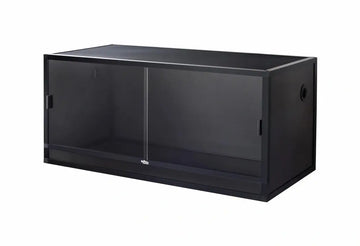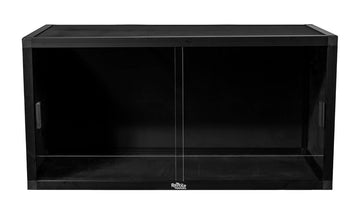Giant day geckos (Phelsuma grandis) are medium-sized arboreal lizards found in the tropical forests of Madagascar. They have an elongated but stout body, tapered snout, thick tail, round eyes, and sticky toe pads. Their soft, velvety scales are usually bright green with spots of crimson on the head. Giant day geckos can grow as large as 12” long.
Giant day geckos are sensitive reptiles that are best classified as intermediate-level pets. With good care, they can live as long as 20 years.
Minimum terrarium size for giant day geckos
The absolute minimum terrarium size for a single giant day gecko is 18”L x 18”W x 36”H. Of course, larger (particularly wider) is always better!
Housing multiple giant day geckos in the same terrarium is not recommended, and may result in fighting and/or breeding if attempted. Do not breed day geckos unless you are fully prepared to accommodate the babies. Breeding is a serious project that should not be attempted casually.
Do giant day geckos need UVB?
Yes! Giant day geckos require UVB lighting for their survival. UVB lighting helps provide a clear day/night cycle, provides all of the vitamin D that your pet needs, supports the immune system, facilitates better digestion, and provides other benefits.
The best UVB bulbs for giant day geckos housed in an 36” tall terrarium are:
- Zoo Med T8 Reptisun 10.0, 24” — 4” above basking branch
- Arcadia ShadeDweller Kit — 6” above basking branch
- Arcadia T5 HO 6%, 22” — 8” above basking branch
For best results, house the UVB bulbs in a reflective fixture. Position the lamp on the same side of the terrarium as the heat lamp. UVB is blocked by glass and plastic, so placing the terrarium in front of a window doesn’t count as “free UVB” — in fact it can make your terrarium too hot due to the greenhouse effect. Don’t forget to replace your bulb every 12 months!
Giant day geckos benefit from plant grow lights as part of their environment as well. Add a ~6500K LED or T5 HO fluorescent grow lamp to provide extra illumination, as well as help any live plants in the terrarium to thrive.This extra illumination will encourage your gecko to be more active and show off its best colors!
Lights should be on for 11 hours/day during winter and 13 hours/day during summer to simulate seasonal changes in day length. All lamps should be turned off at night.
Best temperature for giant day geckos
Giant day geckos should have a basking temperature of 95°F, as measured by a digital probe thermometer with the probe secured to the basking branch. General ambient temperatures should range between 80-86°F. Nighttime temps can drop as low as 72°F.
Provide heat for your gecko with a halogen heat bulb. Halogen bulbs are the best way to imitate the warmth of sunlight indoors, and considered to be a superior form of reptile heating by experts. Do not use red bulbs, or blue bulbs, as these are not as effective.
If you need supplemental nighttime heating, use a lightless heat source like a ceramic heat emitter connected to a thermostat.
Best humidity levels for giant day geckos
Giant day geckos are a tropical species, so the humidity inside their enclosure should be fairly high: 50-70%. Humidity should be measured via digital probe hygrometer, with the probe placed in the middle of the terrarium.
Increase humidity by misting your gecko’s enclosure 1-2x/day with a spray bottle. Mist first thing in the morning and then again at night if needed. Aside from raising humidity, this also provides your gecko with an important source of drinking water!
Best substrate for giant day geckos
Providing a layer of naturalistic substrate (“bedding”) will help maintain correct humidity levels and also helps make your enclosure more attractive! We recommend the following substrates for giant day geckos:
Layering clean, chemical-free leaf litter on top of the substrate can also help with humidity.
Substrate should be at least 2” deep and completely replaced every 3-4 months. Remove poop and urates daily, along with contaminated substrate.
How to decorate a giant day gecko terrarium
An empty terrarium makes for a bored day gecko, reducing its quality of life. Keep your pet entertained and engaged with its environment with the strategic use of décor items that encourage it to exercise natural behaviors!
Since day geckos are arboreal, at bare minimum you will need a branch for your gecko to bask on and some live or artificial foliage for it to hide in. However, it’s best to include other items, such as:
- branches
- vines
- ledges
- live or artificial plants
What to feed to a giant day gecko
Day geckos are omnivores, which means that they need to eat both plant- and animal-based foods to get the right nutrition. In the wild, they primarily eat insects, as well as some flower nectar and fruit. As pets, it’s best to feed them live insect feeders supplemented by high-quality, specially-formulated crested gecko diet (CGD).
How often giant day geckos need to eat depends on age:
- Hatchlings and Juveniles (0-12 months) — insects daily, CGD 2x/week
- Adults (>12 months) — insects 2x/week, CGD 1x/week
Feeder insects for day geckos: dubia roaches, discoid roaches, red runner roaches, crickets, hornworms, silkworms
Best crested gecko diets: Pangea, Repashy, Leapin’ Leachie, Zoo Med, Lugarti, Black Panther Zoological, Gecko Pro
The key to balanced nutrition is variety, so make sure to offer a rotation of as many different foods as possible.
Supplements
You will also need a calcium supplement. We recommend Repashy Supercal NoD, lightly dusted on all feeder insects. It’s okay to occasionally skip a dusting.
Water
Of course, don’t forget small food and water bowls and a feeding ledge! Since day geckos are arboreal, they prefer to eat and drink up off the ground. Change the water daily and scrub the bowl with a reptile-safe disinfectant weekly, or whenever it becomes soiled.
How to handle your giant day gecko
Reptiles generally don’t appreciate petting and handling in the same way that dogs and cats do. Day geckos are one of the types of reptiles that are best to leave alone rather than attempt to handle regularly, as they may slough their skin or drop their tail when grabbed. If you want to interact with your pet day gecko, try hand-feeding it with a pair of feeding tweezers.
*This care sheet contains only very basic information. Although it’s a good introduction, please further your research with high-quality sources. The more you know, the better you will be able to care for your pet!











